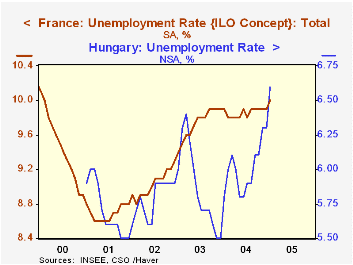 Global| Feb 25 2005
Global| Feb 25 2005January Unemployment Rates Up in France and Hungary, Down in Norway and Brazil
Summary
Labor markets in disparate countries presently face disparate employment conditions. In data reported today, France, for instance, saw its January unemployment rate touch 10%, following more than a year hovering around 9.9%. Rates [...]

Labor markets in disparate countries presently face disparate employment conditions. In data reported today, France, for instance, saw its January unemployment rate touch 10%, following more than a year hovering around 9.9%. Rates rose for both men and women and for adults both over and under age 50. Obviously, a one-decimal move is not much, but it still signals that the French economy struggles, along with most of its neighbors, to find improvement for its labor force.
Hungary has a similar concern, as its unemployment rate rose to 6.6% in January, the highest since these data started monthly publication in 2001 (they are reported as 3-month moving averages, however, and are contiguous with the separate quarterly series also maintained in Haver's EMERGECW database). While some of this latest monthly change is seasonal, weakness in Hungarian employment is clearly the major source of the unemployment problem. A brief spurt in employment occurred in 2003 and kept the unemployment rate steady, but that played out last year, as seen in the table below.
Norway has somewhat the opposite situation, as a modest recovery in employment last year helped to keep the unemployment rate low and steady. In December, it remained at 4.4%, the same as the average for 2004 overall and off a mid-2003 peak of 4.7%.
Brazil calculates its unemployment rate based on both the total working-age population and the "economically active" population. With a large segment not involved in commercial activity, the participation rate is about 57%, so there is considerable difference in the two unemployment measures. The unemployment count in 2004 was 2.49 million; this is 6.6% of the total working-age population and 11.5% of the "economically active" population. "Working age" in Brazil begins at age 10, and last year was 38.06 million people. Data for Brazil are shown in Haver's EMERGELA database.
Whichever unemployment rate base is used, the unemployment rate in Brazil has come down substantially in the last nine months or so. Following some weakness in 2003 and early last year, employment has rebounded and unemployment has fallen sharply. Thus, the unemployment rate relative to the economically active population (what we'd call the "labor force") has fallen from a recent peak of 13.1% in April 2004 to 10.2% in January 2005. Brazil's hesitant recovery continues.
| Unemployment Rates & Related Data | Jan 2005 | Dec 2004 | Nov 2004 | Year Ago | 2004 | 2003 | 2002 |
|---|---|---|---|---|---|---|---|
| France (seas adj) | 10.0 | 9.9 | 9.9 | 9.9 | 9.9 | 9.7 | 9.0 |
| Hungary* | 6.6 | 6.3 | 6.3 | 5.8 | 6.1 | 5.8 | 5.8 |
| Employment (12-mo % change) | -0.7 | -1.1 | -1.4 | -- | -0.6 | -1.3 | 0.1 |
| Norway (seas adj) | -- | 4.4 | 4.4 | 4.6 | 4.4 | 4.5 | 3.9 |
| Employment (12-mo % change) | -- | 0.8 | 0.7 | -- | 0.3 | -0.7 | 0.3 |
| Brazil: % of Working Age Population** | 5.7 | 5.4 | 6.1 | 6.6 | 6.6 | 7.0 | 6.4 |
| % of Economically Active Population | 10.2 | 9.6 | 10.6 | 11.7 | 11.5 | 12.3 | 11.7 |
Carol Stone, CBE
AuthorMore in Author Profile »Carol Stone, CBE came to Haver Analytics in 2003 following more than 35 years as a financial market economist at major Wall Street financial institutions, most especially Merrill Lynch and Nomura Securities. She had broad experience in analysis and forecasting of flow-of-funds accounts, the federal budget and Federal Reserve operations. At Nomura Securities, among other duties, she developed various indicator forecasting tools and edited a daily global publication produced in London and New York for readers in Tokyo. At Haver Analytics, Carol was a member of the Research Department, aiding database managers with research and documentation efforts, as well as posting commentary on select economic reports. In addition, she conducted Ways-of-the-World, a blog on economic issues for an Episcopal-Church-affiliated website, The Geranium Farm. During her career, Carol served as an officer of the Money Marketeers and the Downtown Economists Club. She had a PhD from NYU's Stern School of Business. She lived in Brooklyn, New York, and had a weekend home on Long Island.





